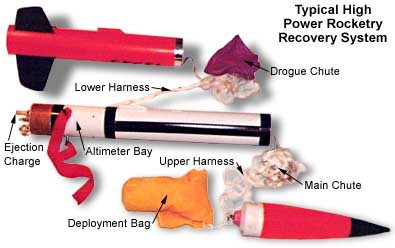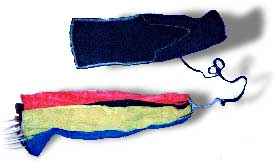A recovery system is used to return a rocket to the ground without damage to the rocket or objects on the ground. The typical recovery mechanism is a parachute. The components of one rocket’s recovery system are shown below.

This rocket uses an altimeter to split the rocket at about the midpoint at apogee. A small (drogue) parachute is used to stabilize the rocket’s descent, but not to significantly slow the rocket. Causing the rocket airframe to fall horizontally to the ground maximizes drag, slowing the rocket. At a low altitude like 300’ or 600’ the altimeter causes the main parachute to be deployed from the top section of the rocket. The ejection charge for the main parachute is located above the altimeter bay and cannot be seen.
The main parachute is stuffed into a Nomex cloth deployment bag. The bag protects the parachute from the ejection charge.
Single Stage Recovery
Some rockets use only a single (main) parachute, which is deployed at apogee. An ejection charge activated by the motor, or an electronic device like an altimeter or timer may be used to deploy the parachute.
Two Stage Recovery
Two stage recovery uses a drogue parachute deployed at apogee and the main parachute deployed at a low altitude like 300’ or 600’. This is done to minimize the distance a rocket drifts. This technique uses an electronic device like an altimeter or timer to deploy the main parachute, and it also usually deploys the drogue parachute. Sometimes a streamer is used instead of a drogue parachute.
If a drogue parachute is deployed at apogee and the rocket is suspended from the parachute rather than falling horizontally, a larger drogue parachute will be needed than if the airframe falls horizontally, which adds weight. A horizontally falling airframe has maximum drag, which helps slow the rocket. Therefore a smaller, and lighter, drogue chute can be used.
Parachute Deployment Bag

A deployment bag is literally a bag into which a parachute is packed. A bag can have one or more purposes, depending upon how the recovery system works. The two common purposes in a high power rocket is to protect the parachute from hot ejection charge gases and particles, and for orderly deployment. A common material for deployment bags is Nomex cloth, which is fire resistant.
Orderly deployment means that the parachute’s suspension lines are fully extended, and the harness is tight before the parachute inflates. This reduces the opening shock forces. A large parachute opening force can tear a rocket or recovery system apart.
A pilot parachute (a small parachute) may be used to pull the deployment bag off the parachute. Some deployment bags are designed to serve as its own pilot chute.
Submitted by: Dean A. Roth